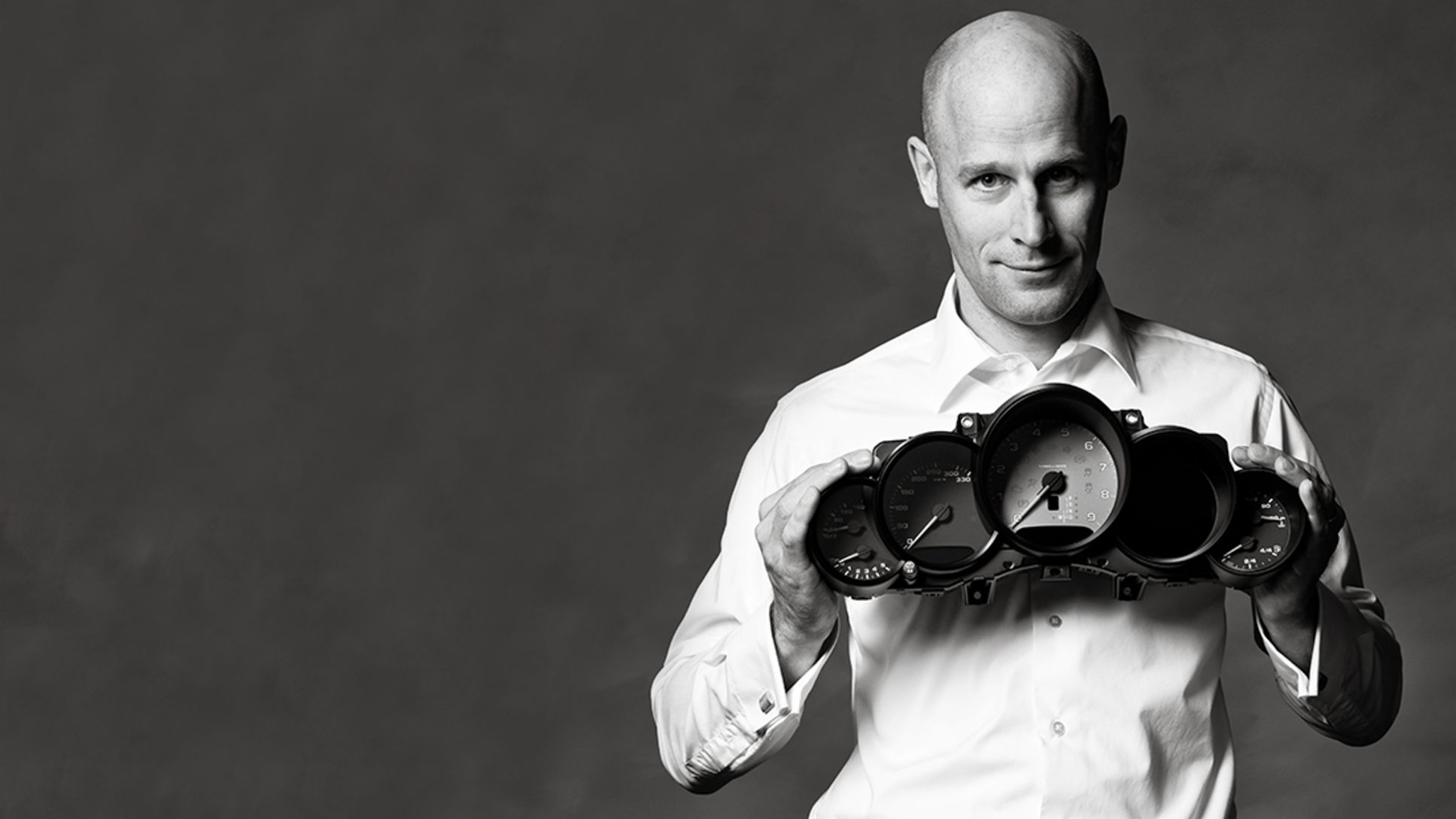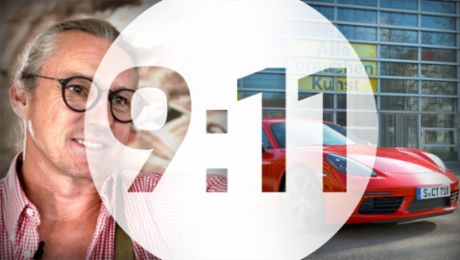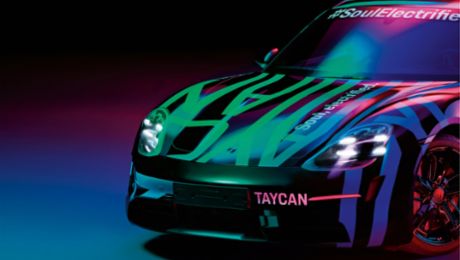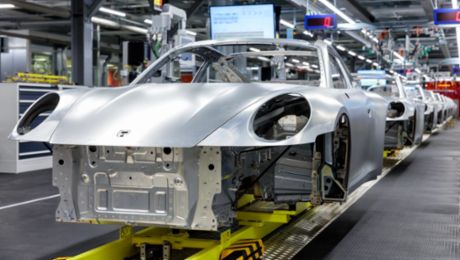A 911 incites emotions. It is the fascinating technology that does it. People create that technology with enormous enthusiasm and even greater know-how. They are committed to making the 911 even better. That is how things are done at Porsche, in this case for 47 years, from one evolutionary phase to the next, through all the 911 generations. Lighter and more effi cient, more agile and dynamic—these are the adjectives that drive Porsche employees to come ever closer to the vision of the perfect sports car. An effi cient organization focused on the 911 model series is needed to provide the various experts from Complete Vehicle, Powertrain, Chassis, Body, and Electrical, as well as the specialists from Procurement, Production, and Sales/Marketing with a shared environment for collaboration. This organization is the control center of the entire effort, from concept to production. The following selection of “Elfers Helfer” (911 Helpers) features the project managers of a complex development process with a vast number of helpers. They prefer managing to being photographed. But they have made an exception for us.
Everything that concerns the 911 comes across his desk: August Achleitner, the head of the 911 model series, is a man with unadulterated Porsche genes. He has been with the company for 28 years. Th e fi rst component for which he was responsible was the rear brake disk of the 911 Turbo, Type 964. Now he is rolling out the third 911 generation. He is responsible for Engineering, Production, Sales/Marketing, and the achievement of project objectives. Jessica Gerlach is his assistant. She handles daily tasks, scheduling, preparation of presentations, lectures, meetings, and coordination with the press and with Sales/Marketing. Th ere is one important milestone she has not yet reached: “I’m really looking forward to the opportunity to drive the new 911.”
Does the new 911 meet the customers’ expectations as well? Christoph Henrici in Sales/Marketing of the model series ensures that Engineering knows what the customers want. In addition to driving a high level of innovation, this task requires meeting the dissimilar needs of diff erent markets around the world, ensuring correct and market-specifi c sales literature, and making all necessary arrangements for Marketing, Sales, and Aftersales. Martin Weigelt represents the colleagues in Aftersales who develop maintenance and repair concepts with a view to achieving low operating and maintenance costs as well as cost-efficient insurance classifi cations.
His teammates are no dummies. “We’re responsible for all components that are wired, and for their networking,” says Dr. Philipp Burmester. Intelligent control devices interconnect the engine, transmission, chassis, and body. Th ey master the challenges of combining high performance and low fuel consumption, of driving comfort and sports-car potency. Additional responsibilities include safety and lights as well as passenger comfort: among the latter, the dual-zone automatic climate control and, in the high-end range, the concert-hall experience. “I enjoy my music best with the Burmester Sound System in the new 911,” notes the expert in electrical and electronics systems.
Fascinating technology plus unrivaled design—that alone still does not make a 911. It is the interaction of forces without gaps or irregularities—an absolute masterpiece, for which the topranking engineering project managers in the Complete Vehicle unit are responsible. Keeping an eye on the entire program covers a lot of territory. At the outset it includes responsibility for the package, the design, and the digital prototypes. Later it is about construction and testing of the prototypes, coordination of aero- and ther modynamics, acoustics and vibrations in the vehicle. Then there are responsibilities related to vehicle safety and worldwide model designations, including measurements of driving performance and especially of fuel consumption. Michael Schätzle, Bernd Kahnau, Thomas Veit und Jürgen Jäger look after this at Porsche.
Communication is everything, and that goes for a Porsche too. Th e tires receive information and transmit it directly to the driver through the steering system. And this communication works equally well in the opposite direction. Th e ultimate consequence: the sports car always tracks correctly. In this field Porsche is the master. The chassis specialists like Ulrich Morbitzer have made everything in the new Porsche even better. Larger tires (up to 20 inches) and wheels, for the fi rst time electrically assisted power steering, and the new roll stabilization, among other features, called for a very deft touch in the tuning process.
What they like best is giving the green light. That means everything is okay, all is going exactly as planned. And it makes all the guys on the Project Management team of the 911 model series (Achim Lamparter, Martin Stäbler und Alwin Becker) feel good, because they control the product development process from the first specifi cations to production. That includes project planning, interdepartmental scheduling, budget planning, and assessing the readiness level of the new technology. Only when the development stays within specifi ed fi nancial and scheduling parameters will a new 911 actually roll off the line.
Even during the development stage of the new 911, optimum conditions are being planned and implemented for the subsequent production phase. Christian Timpte is in charge of ensuring on-time delivery by the suppliers of all thirdparty components. What matters are not only the quality and the cost, but also the capability of the suppliers to meet logistical requirements and to deliver required quantities, because production at Porsche is lean, flexible, and state-of-the-art—and planned as effi ciently as a pit stop.
All the things Porsche engineers come up with! But can the 911 also be made effi ciently in large-scale production? Th is question has to be resolved early on by Peter Katzschner and Matthias Joussen with the other experts from Production, as do specific issues concerning investments and feasibility. Th e toughest challenge with respect to the new 911 was the body-in-white. Combining aluminum with steel components called for an entirely new production technique, known as self-pierce riveting with additional glue joints. It just goes to show there is almost no limit to what they’ll do for a new, lighter Porsche.
The powertrain–technically–refers to the engine and transmission. In the 911, that is the heart and soul of the vehicle—the essentials that generate power and transfer it directly to the road. The challenges in the Powertrain unit for Thomas Krickelberg and Christiane Heinen: more power, an even perkier engine, enhanced sound, and substantially reduced fuel consumption. To achieve these objectives, Porsche engineers optimized the gasoline direct injection, the electronically controlled hydromechanical valve lift and timing system of the VarioCam Plus intake camshaft, and the new temperature management system. Entirely new are the automatic start-stop function and the world’s fi rst sevengear manual transmission for a passenger car.
Lose weight! For the Body unit it’s an absolute requirement in every new evolutionary stage. Obviously, the materials and their processing must meet more challenging requirements as the years go on. The solution is hybrid lightweight construction. This means, first of all, that an optimized mix of aluminum and steel strengthens the weight-bearing structure of the 911. And there were additional challenges for the body specialists Dominik Vetter, Henning Rohardt and the team of Horst Nonner: the new interior with the sloping center console, new seats, a larger sunroof, and more air-conditioning choices; last but not least, the body required very close coordination between the engineers and the designers.
Info
Text first published in the Porsche customer magazine Christophorus, no. 352
Consumption data
911 (Type 991): Combined fuel consumption: 9.0 – 8.2 l/100 km; CO₂ emission: 211 – 191 g/km




